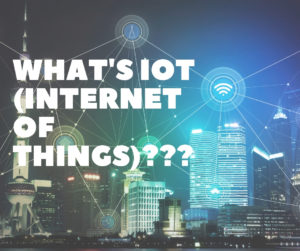 I haven’t written much about IoT (the Internet of Things–see the end of this article for more resources on IoT) and education. I do talk about it in my Digital Citizenship grad school class (if you click the link, it’s MTI 557) but haven’t turned those ideas into blogs yet. Thank you, Jane, Ask a Tech Teacher contributor, for writing a quick overview of that topic’s intersection with education.
I haven’t written much about IoT (the Internet of Things–see the end of this article for more resources on IoT) and education. I do talk about it in my Digital Citizenship grad school class (if you click the link, it’s MTI 557) but haven’t turned those ideas into blogs yet. Thank you, Jane, Ask a Tech Teacher contributor, for writing a quick overview of that topic’s intersection with education.
Even though 86% of universities currently educate students with disabilities, only 24% of the schools say that they offer those students assistance “to a major extent.” The schools that do place emphasis on the needs of their students often have programs that encourage accessibility as well as accessible classrooms. Smart technology that is connected by the Internet of Things (IoT), however, is beginning to change all of this by making classrooms and campuses around the country more accessible while crafting a better learning environment for every student.
Crafting Smart, Accessible Learning Environments
Students with physical disabilities that affect their mobility can often find it hard to access learning spaces. Integrating smart, connected technology into college campuses is a way to prevent these issues from affecting disabled students or those with lower mobility. Mobility-friendly stairlifts and motion-sensitive doors, for example, are ways in which smart technology is used to allow students with disabilities to easily access buildings and classrooms. Using smart technology to accomplish this is nothing new. Other industries that cater to the elderly population, people with limited mobility due to obesity and the housing sector already utilizing technology to improve health and increase accessibility. All of these solutions have come to fruition based on, first, the concept of universal design and, second, the idea that technology can be used in innovative ways to enhance life in practically any way possible.
Adapting Physical Learning Spaces
Researchers and educators at Vanderbilt have already begun to implement accessibility through technology into their institutional framework, and it all begins by first analyzing the physical learning spaces found on campuses. Their studies note that this must begin by considering the location of each building as well as the location of each classroom within that building. The lighting, tables, projection, and whiteboard can all then be organized in a way that optimizes mobility and access. Furthermore, making the lighting and classroom accessories connected to IoT and smart in general can help ensure those with limited mobility are able to either operate the devices when needed or connect to a platform that allows them to participate more efficiently in discussions and other learning projects. While assistive learning technology has been around for years, what has been truly transformative has been the connection of the Internet of Things what that same technology. For some students with physical disabilities, the ability to virtually connect to a lecture or even remotely access a teacher’s aid can make all of the difference.
The Future of Connected Learning
Creating a learning environment that promotes accessibility ensures that anybody has the ability to access what they need in order to succeed. Further research and implementation will be needed regarding how smart technology can be used to both connect students with disabilities to their campus as well as facilitate the ease with which they can interact with it. Open layout classrooms, mobility-friendly stairlifts, smart classroom technology, and assistance are all just the beginning of the battle that is making educational spaces adequately accessible by all.
–Jane Sandwood is a freelance writer, editor and former tutor, homeschooler, and mother of two teenage daughters.
More about IoT
What is the Internet of Things?
Jacqui Murray has been teaching K-18 technology for 30 years. She is the editor/author of over a hundred tech ed resources including a K-12 technology curriculum, K-8 keyboard curriculum, K-8 Digital Citizenship curriculum. She is an adjunct professor in tech ed, Master Teacher, webmaster for four blogs, an Amazon Vine Voice, CSTA presentation reviewer, freelance journalist on tech ed topics, contributor to NEA Today and TeachHUB, and author of the tech thrillers, To Hunt a Sub. You can find her resources at Structured Learning.





































1 thought on “How Smart Tech and IoT are Making Educational Spaces More Accessible”
Comments are closed.